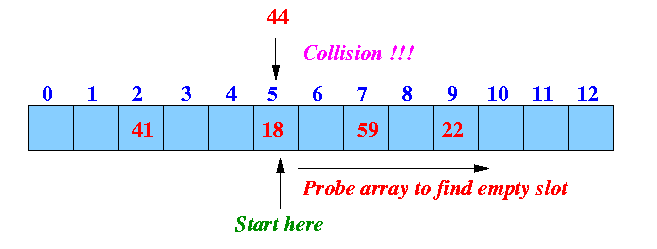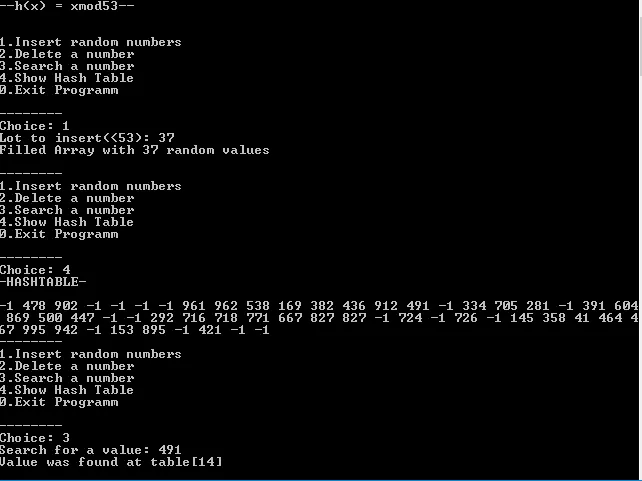
It's me again with the second part for Hashing! The last part is here and you should read it first to understand some things better, cause here I will only implement Linear Probing in C. I will also explain what needs to be changed to implement another Open Address Method directly! So, let's get started!
Linear Probing Implementation:
It's pretty easy to implement this type of a Hashtable. It's a simple Array of specific "prime" size and we will insert the values in the hashindex or the next available space if a collision happens. I think the Code will explain itself!
#include <stdio.h>#include <stdlib.h>#include <string.h>#define N 53#define h(x) (x % m) //h(x) = x mod m
// function declarationsvoid fill_array(int *A, int table_range, int number);void insert_table(int *table, int table_range, int hash_index, int val);void print_table(int*table, int table_range);int search_table(int *table, int table_range, int val);void delete(int *table, int table_range, int val);
int main(){ int *table; // hashtable int i, j, n, choice, index; int search, val; int num = 0; // insert count (I don't check deletions)
printf("--h(x) = xmod%d--\n", N); printf("\n\n"); table = (int*)malloc(N*sizeof(int)); // initialize to -1, value that represents emptyness for(i = 0; i < N; i++){ table[i] = -1; } while(1){ printf("1.Insert random numbers\n"); printf("2.Delete a number\n"); printf("3.Search a number\n"); printf("4.Show Hash Table\n"); printf("0.Exit Programm\n"); printf("\n--------\n"); printf("Choice: "); scanf("%d", &choice); switch(choice){ case 0: exit(0); case 1: // insert random numbers do{ printf("Lot to insert(<%d): ", N-num); scanf("%d", &n); }while(N - num < n); num += n; fill_array(table, N, n); printf("Filled Array with %d random values\n", n); printf("\n--------\n"); break; case 2: // delete a number printf("Give a value you want to delete: "); scanf("%d",&search); delete(table, N, search); printf("\n--------\n"); break; case 3: // search for a number printf("Search for a value: "); scanf("%d",&search); index=search_table(table, N, search); if(index == -1){ printf("This value doesn't exist on HashTable!\n"); } else{ printf("Value was found at table[%d]\n", index); } printf("\n--------\n"); break; case 4: //print hashtable printf("-HASHTABLE-\n\n"); print_table(table, N); printf("\n--------\n"); break; } } return 0;}
// FUNCTIONSvoid fill_array(int *A, int table_range, int number){ int i; int num; for(i=0; i<number; i++){ num = rand()%1000; // random number from 0 to 999 insert_table(A, table_range, num % table_range, num); }}
void insert_table(int *table, int table_range, int hash_index, int val){ if(table[hash_index] == -1 && hash_index < table_range){ table[hash_index] = val; return; } // go to the next index using modulo when it is outside of the array hash_index = (hash_index+1) % table_range; if(hash_index == val % table_range){ printf("Hashtable is full!\n"); return; } insert_table(table, table_range, hash_index, val); }
void print_table(int *table, int table_range){ int i; for(i=0;i<table_range;i++){ printf("%d ",table[i]); }}
int search_table(int *table, int table_range, int val){ int i; i = val % table_range; // we search the whole array starting from the hashindex // cause some value in between could have been deleted // and we then would have false results do{ if(table[i] == val){ return i; } i = (i+1) % table_range; }while(i != val % table_range); return -1;}
void delete(int *table, int table_range, int val){ int index; // we call the search function to get the index index = search_table(table, table_range, val); if(index == -1){ printf("Value %d doesn't exist on HashTable!\n", val); return; } table[index] = -1; printf("Value %d was found at table[%d] and was deleted!\n", val, index);}An example run would look like this:

How to implement the other Methods:
To implement the others we only have to change this one line!
hash_index = (hash_index+1) % table_range;When quadratic probing we will have to put it inside of a for loop and starting going in quadratic steps like that:
hash_index = ((hash_index) + i^2 ) % table_range;Because my function is recursive I would have to put the i value as a parameter, starting it out with 0 so that we check the normal hash_index first!
So, the insertion using Quadratic Probing would look like this:
void insert_table(int *table, int table_range, int hash_index, int val, int i){ if(table[hash_index] == -1 && hash_index < table_range){ table[hash_index] = val; return; } hash_index = ((hash_index) + i^2 ) % table_range; if(hash_index == val % table_range){ printf("Hashtable is full!\n"); return; } insert_table(table, table_range, hash_index, val); }Double Hashing is easy! We will have to put not i^2 but i*the second hashfunction. That way we end up with Double Hashing.
The Insertion Function for Double hashing looks like this:
void insert_table(int *table, int table_range, int hash_index, int val, int i){ if(table[hash_index] == -1 && hash_index < table_range){ table[hash_index] = val; return; } hash_index = (hash_index + i*(val % H)) % table_range; if(hash_index == val % table_range){ printf("Hashtable is full!\n"); return; } insert_table(table, table_range, hash_index, val); }Where H should be another value like N, that is smaller than N, but again a prime number!
This is actually it! Hope you enjoyed all that Hashing stuff!
Next time in Programming we will get into Graphs in Java Implementation!
Bye!
